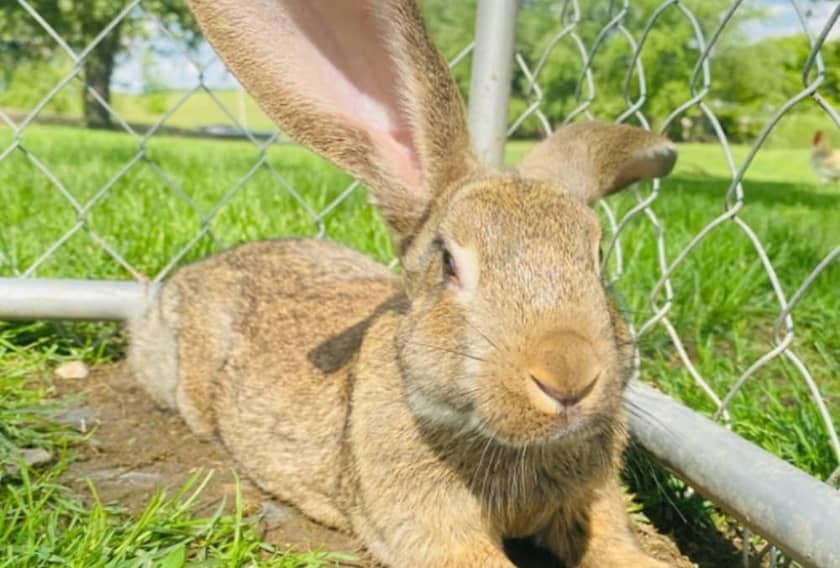The Tokay Gecko (Gekko gecko) is one of the world’s most aggressive and vibrant reptiles, and it is known for its large size, bold coloration, and distinctive vocalizations. Tokay geckos are native to Southeast Asia and are not as common as leopard geckos.
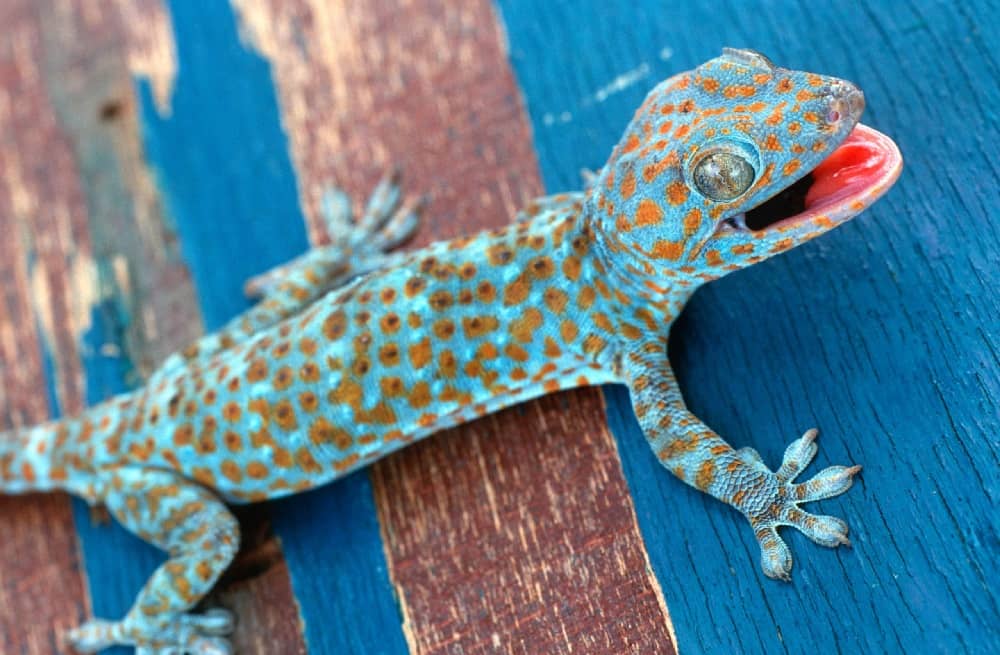
They typically have a grayish-blue or light-gray base color. Their bodies are covered with bright orange or red spots and light blue spots, which gives them a beautiful and exotic look. The coloration can vary based on mood, health, and environment. Tokay Geckos have large, round eyes with vertical slit pupils, which are characteristic of nocturnal reptiles. Their eyes are often a golden or orange hue and are large and round with vertical slit pupils.
Tokay Geckos have large, adhesive toe pads that allow them to easily climb vertical surfaces. The pads have microscopic hairs (setae) that help them adhere to smooth surfaces. To take care of them requires specific knowledge and dedication. They are primarily insectivores, consuming a diet of crickets, roaches, mealworms, and other live insects. Occasionally, they may also eat small vertebrates like pinkie mice or smaller lizards.
Tokay Gecko Size
Tokay Geckos are the second largest type of gecko morph. among the largest geckos. The size of an adult tokay gecko typically ranges from 1–15 inches (25 to 35 cm) in length, including the tail. Some larger males may even grow up to 16 inches (40 cm). They have a stout, muscular body with a broad, flat head. Their tail is long and strong, which helps them in balance and defense.
Tokay Gecko Lifespan
Tokay Geckos generally have a lifespan of 10 to 15 years in captivity with proper care, but some can live up to 20 years or more in ideal conditions.
Male vs. Female Tokay Gecko
Male Tokay Geckos tend to be larger and bulkier, with more muscular bodies and broader heads. Females are generally smaller and slimmer compared to males. Females usually have duller colors with less pronounced spots. Males have noticeable hemipenal bulges at the base of the tail, which are the most reliable way to sex them, but females lack these bulges. They possess distinct rows of femoral pores along the inner thighs, which secrete pheromones used in marking territory. Males are generally more territorial and aggressive than females, while females tend to be more passive.
Behavior and Temperament
Tokay Geckos are nocturnal, which means they are active at night and sleep and tend to hide and rest during the day. They are known for their aggressive temperament, especially males. They are notorious for their defensive nature, especially when handled or disturbed. And, they can also bite if threatened. These geckos are highly vocal, producing a loud “To-kay” sound, which is where they get their name. This call is used for territorial purposes or to attract mates.
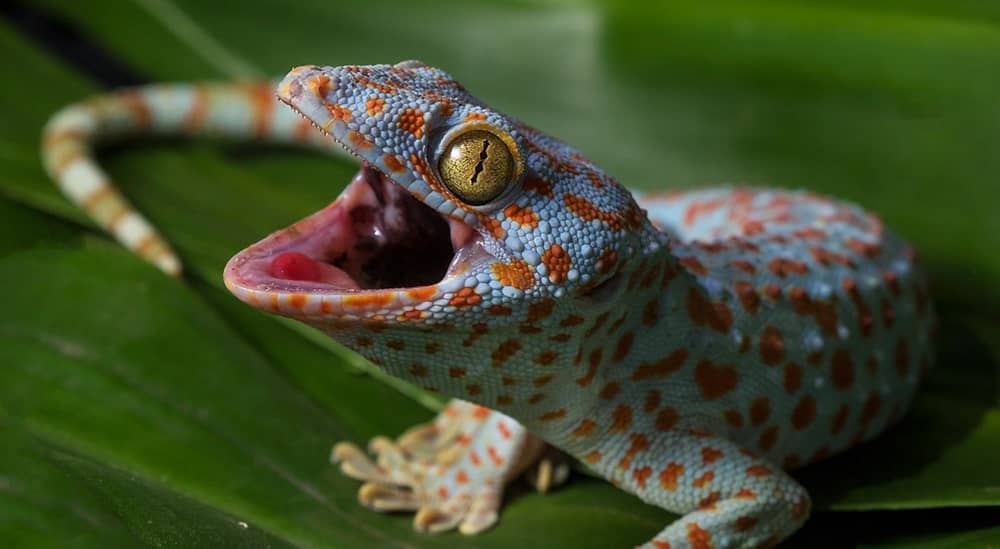
As arboreal reptiles, Tokay Geckos love to climb. They are active explorers of their environment, so they need vertical spaces and hiding spots within their enclosure. If they see any danger from their predators, they can detach their tails to save themselves.
How to Care for a Tokay Gecko?
To maintain your pet tokay gecko’s health, you need to be careful with their requirements, whether it’s diet, grooming, housing, or exercise.
Tokay Gecko Food
Tokay gecko food should be balanced and nutritious. They are insectivores, meaning their primary diet consists of live insects, like crickets, mealworms, roaches, superworms, and waxworms. Crickets are a staple in their diet and you need to ensure they are appropriately sized. Worms should be given in limit as they have high-fat content, while roaches like Dubia or Madagascar hissing cockroaches are excellent sources of protein and can be fed live or pre-killed.
You should always provide fresh, clean water in a shallow dish. It’s important to change the water daily to ensure hydration and prevent contamination. You can also offer some occasional treats, like pinkie mice, for more protein. Add a calcium supplement (without vitamin D3) to their diet to ensure they receive enough calcium for bone health. You can use a reptile-specific multivitamin supplement once every 1-2 weeks to provide additional essential nutrients.
If you have juveniles, you need to feed them daily and offer small amounts to ensure they get enough nutrients for growth. And, for adult tokay geckos, you need to feed them every 2-3 days, depending on their appetite and activity level. Always provide food in moderation to avoid overfeeding.
Tokay Gecko Enclosure
If you want your tokay gecko to stay healthy and strong, free from health issues, you have to keep the necessities for caring for tokay geckos, like their enclosure.
Tokay Gecko Tank Size
Tokay Gecko tank size is at least 20 gallons in volume and should ideally be housed in a vertical enclosure. A large enclosure is always better to provide ample space for climbing and exploring. A 30-gallon or larger tank is recommended for an adult, especially if you’re housing a male, as they can be territorial.

The enclosure should be tall, have vertical space with a secure lid to prevent escape, and should include branches, climbing surfaces, and plenty of hiding spots to mimic their natural habitat, as they love to hide in caves in the wild. This vertical enclosure not only supports their natural climbing instincts but also helps maintain appropriate temperature gradients and humidity levels.
Important Tip: Never house more than one tokay gecko in the enclosure, especially males, as they result in a fight. Also, set up their enclosure in your bedroom as they keep you awake through their vocalizations.
Temperature for Tokay Gecko Tank
The right temperature for the tokay gecko tank is essential for their health and comfort. The ideal temperature for a tokay gecko tank should be between 80°F and 90°F (27°C to 32°C) during the day, with a basking area reaching around 90°F (32°C) to provide a warm spot for the gecko to regulate its body temperature.
At night, you can drop the temperature to around 70°F to 80°F (21°C to 27°C). You can use heat lamps or ceramic heat emitters to give heat and should also ensure that cooler areas are also available for the gecko. You can use a thermometer to monitor the temperature in different parts of the enclosure.
Tokay Gecko Humidity Level
Tokay Gecko humidity level is vital for their health, as they thrive in a tropical environment with high moisture levels. The humidity level should be kept between 60% and 80% in their enclosure, and do not let it drop by 50%. This level of humidity supports their shedding process, helps prevent respiratory issues, and ensures overall well-being. You need to do regular misting of the enclosure to maintain its humidity level, ideally done once or twice daily. You can check or measure the tokay gecko humidity level with a digital hygrometer.
Tokay Gecko Light Setup
It is important for you to consider their nocturnal nature and specific lighting needs before tokay gecko light setup. Unlike diurnal reptiles, Tokay Geckos do not require intense UVB lighting, as they are active at night. However, you can provide a low-wattage basking light during the day to help maintain the temperature gradient in the enclosure.
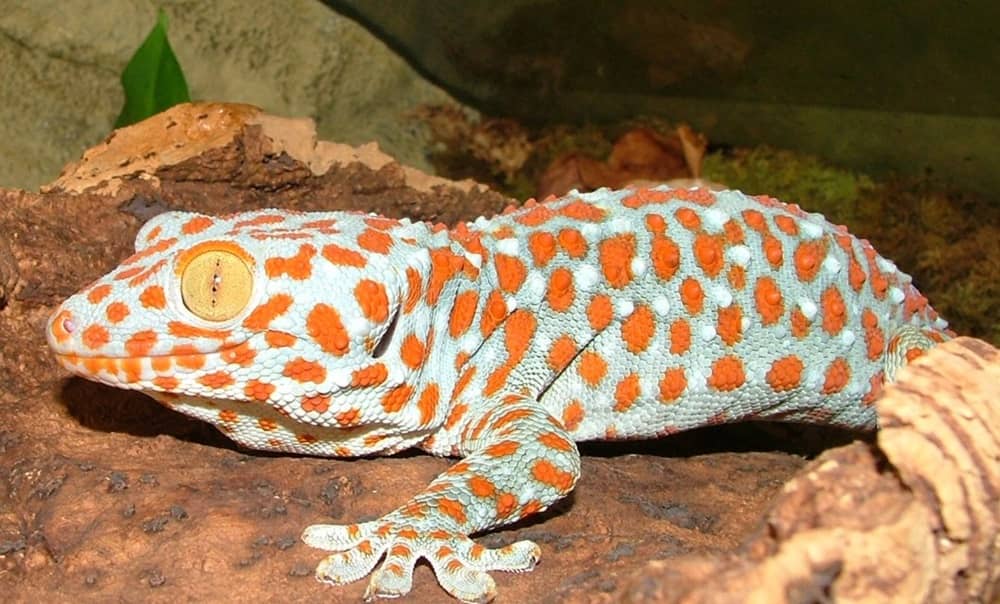
This light can simulate a natural day-night cycle, which helps to regulate the gecko’s circadian rhythm. It is advisable to use a heat bulb that emits minimal visible light and allows the gecko to bask without disrupting its natural behaviors. You need to maintain a consistent light cycle of about 12 hours on and 12 hours off to support your gecko’s health and well-being.
Tokay Gecko Substrate
The right Tokay gecko substrate should be able to retain moisture while providing a safe and comfortable surface for the gecko to move around. You can use coconut fiber, reptile-safe soil, or sphagnum moss, which helps to maintain the humidity levels in the enclosure. These substrates are also beneficial in shedding, as they allow the gecko to rub against them without causing injury.
You can also use paper towels in Gecko’s shedding. It is important to avoid substrates like sand or loose gravel, as they can cause impaction if ingested and are difficult to clean. You need to regularly monitor the substrate for cleanliness to ensure the well-being of your pet.
How to Handle a Tokay Gecko?
To handle a Tokay gecko requires caution and patience due to their naturally aggressive and territorial behavior. As they do not like to be handled, it’s best to limit handling, as these geckos can be easily stressed by excessive interaction. When you do need to handle them, ensure you approach them slowly and calmly to avoid startling the gecko. You can start by allowing the gecko to get habitual to your presence by placing your hand near its enclosure without trying to touch it.
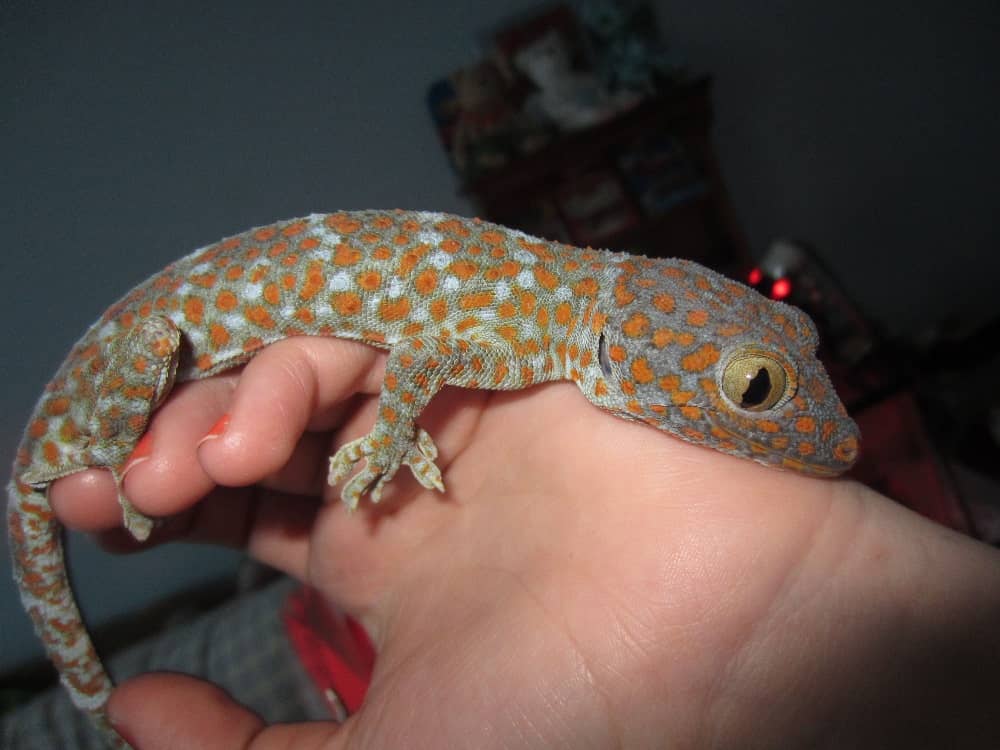
Once it seems comfortable, gently scoop it up with both hands, supporting its body and allowing it to feel secure. You can use gloves if necessary, as Tokay Geckos can bite when they feel threatened. When you are holding, keep the gecko low to the ground to prevent injury in case it jumps. Also, do not handle them for a longer time; limit handling to a few minutes to minimize stress. With time, patience, and gentle interactions, Tokay Geckos may become more tolerant of handling, but they prefer to be observed rather than frequently touched.
Exercise For Tokay Geckos
Exercise for tokay geckos is as crucial as their enclosure and diet. As naturally arboreal creatures, they thrive in environments that encourage climbing and exploration. So, you can create a vertically oriented enclosure filled with branches, vines, and climbing surfaces that mimic their natural habitat. Also, you can add items like cork bark and reptile-safe decor that not only provide climbing opportunities but also hide spots that promote natural behaviors.

Additionally, give some supervised time outside the enclosure in a safe, controlled environment that can encourage exploration and activity. You can engage them in interactive feeding, such as using feeding tongs to move insects around, which can also motivate them to hunt and provide them with both physical exercise and mental stimulation.
Common Health Issues of a Tokay Gecko
Tokay geckos are generally hardy reptiles, but like any pet, they are prone to some common health issues.
Respiratory Infections
Respiratory infections can occur in Tokay Geckos due to poor husbandry practices, such as inadequate temperature or humidity levels. Wheezing, open-mouth breathing, lethargy, and nasal discharge can be the symptoms for this. You need to ensure to maintain proper humidity and temperature in their enclosure.
Mites and Parasites
External parasites like mites can infect your pet tokay geckos, which leads to irritation and potential anemia. Scratching, lethargy, and visible mites on the skin can be the signs. Internal parasites can also be a concern, which leads to weight loss, diarrhea, and other digestive issues. So you need to ensure regular veterinary check-ups and keep the environment clean.
Metabolic Bone Disease (MBD)
Metabolic bone disease (MBD) is caused by a lack of calcium and UVB exposure, which leads to weak bones and deformities. Lethargy, tremors, and difficulty moving can be it’s symptoms. You should provide a proper diet, calcium supplementation, and access to UVB light.
Obesity
Obesity can occur if your pet tokay geckos are overfed or not given enough opportunities for exercise. Lethargy and difficulty moving are the symptoms of obesity in Tokay Gecko. To prevent obesity, you need to provide a balanced diet, avoid overfeeding, and encourage activity through climbing structures in their enclosure.
Veterinary Treatment
If they are affected by some infections or health issues, the veterinary treatment for Tokay Gecko is important. To maintain the health and well-being of tokay geckos, you need to visit a vet. They will conduct a thorough physical examination, along with diagnostic tests such as fecal analysis or blood tests, to check overall health.
Grooming Tokay Gecko
Tokay gecko grooming is minimal compared to other pets, as these reptiles are relatively low-maintenance when it comes to personal care. But still, there are some grooming practices to ensure their health and well-being. You need to maintain a clean environment, which includes regularly cleaning the enclosure and replacing the substrate to prevent bacterial growth and keep your gecko healthy.
While Tokay Geckos do not require baths, you can give occasional misting, which can help with hydration and aid in shedding. Additionally, you need to monitor their nails; if they become overly long, you may need to trim them carefully to prevent injury or discomfort. Always use specialized reptile nail clippers to avoid damaging the toes. You have to regularly check your Tokay Gecko for any signs of skin problems, such as lesions or discoloration, as early detection can help address potential health issues promptly.
Purchasing a Tokay Gecko
When purchasing a tokay gecko, you should learn about the species’ needs, such as its diet, environment, and typical health problems. They can be purchased from a reputable reptile-focused pet shop. Additionally, make sure the store keeps its animals’ living quarters hygienic and sanitary. Another option is to purchase from a respectable Tokay Gecko breeder. Breeders can offer comprehensive details regarding the gecko’s ancestry, medical background, and maintenance requirements. Additionally, you can contact online breeders to choose the ideal tokay gecko for you.
It would help if you looked for indications of good health before buying a tokay gecko. Check for appropriate body weight, healthy skin free of discolorations or blemishes, and clear eyes. Select a tokay gecko that has no visible ribs or pelvic bones. Additionally, there shouldn’t be any skin lumps, as these could be signs of a broken bone or infection.
The cost of purchasing a tokay gecko is around $30 to $100, depending on factors like age, size, and where you buy it. Rare color morphs or captive-bred geckos may be expensive. Tokay Geckos For Sale
Reproduction and Breeding
Related Species to a Tokay Gecko
- Crested Gecko (Correlophus ciliatus)
- Leopard Gecko (Eublepharis macularius)
- Day Gecko (Phelsuma)
Interesting Facts About a Tokay Gecko
- Tokay Geckos are known for their distinctive “to-kay” call, which males use to attract mates and establish territory.
- Tokay Geckos are known for their territorial and aggressive behavior, especially when threatened or handled.
- Tokay Geckos have a powerful bite and will often hold on tightly if they feel threatened.
- Tokay Geckos are tree dwellers, preferring vertical spaces filled with branches and hiding spots.
- Tokay Geckos possess specialized toe pads that allow them to climb smooth vertical surfaces, including glass.
- Like many other gecko morphs, Tokay Geckos can detach and regenerate their tail as a defense mechanism when threatened by predators.
- Tokay Geckos can slightly change their skin color to blend into their surroundings or as a response to mood and environmental factors.
- Tokay Geckos are primarily active at night, hunting for insects and small prey under the cover of darkness.
- In some Southeast Asian cultures, Tokay Geckos are believed to bring good luck, while others view them as omens or symbols of protection.
- Tokay Geckos have large eyes with vertical pupils, allowing them to see well in low light.

Frequently Asked Questions
Question 1: What size tank does a Tokay Gecko need?
Answer: A single adult Tokay Gecko requires at least a 20-gallon tank, though a vertical enclosure around 18x18x24 inches is ideal due to their arboreal nature.
Question 2: What should the humidity level be for a Tokay Gecko?
Answer: Tokay Geckos thrive in humidity levels of 60% to 80%. Mist the enclosure regularly to maintain this level, especially during shedding periods.
Question 3: How often should I feed my Tokay Gecko?
Answer: Adult Tokay Geckos should be fed 3-4 times a week, while juveniles may
Question 4: Do Tokay Geckos need company?
Answer: Tokay Geckos are territorial and solitary creatures. It’s best to house them alone to prevent fighting, especially between males, which can result in serious injuries.
Question 5: Can Tokay Geckos change color?
Answer: Yes, Tokay Geckos can slightly change their color depending on their mood, health, or environment. They may darken or lighten their skin to blend into their surroundings or when stressed.
Question 6: Why do Tokay Geckos make so much noise at night?
Answer: Tokay Geckos are nocturnal and use their loud “to-kay” calls to communicate, attract mates, and establish territory. These vocalizations are especially prominent during the breeding season.
Conclusion








